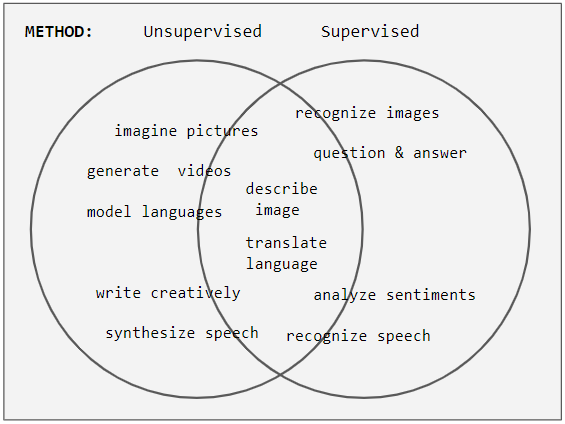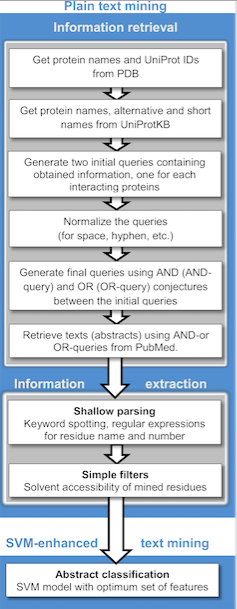|
Co-training
Co-training is a machine learning algorithm used when there are only small amounts of labeled data and large amounts of unlabeled data. One of its uses is in text mining for search engines. It was introduced by Avrim Blum and Tom Mitchell in 1998. Algorithm design Co-training is a semi-supervised learning technique that requires two ''views'' of the data. It assumes that each example is described using two different sets of features that provide complementary information about the instance. Ideally, the two views are conditionally independent (i.e., the two feature sets of each instance are conditionally independent given the class) and each view is sufficient (i.e., the class of an instance can be accurately predicted from each view alone). Co-training first learns a separate classifier for each view using any labeled examples. The most confident predictions of each classifier on the unlabeled data are then used to iteratively construct additional labeled training data. The ori ... [...More Info...] [...Related Items...] OR: [Wikipedia] [Google] [Baidu] |
Semi-supervised Learning
Weak supervision (also known as semi-supervised learning) is a paradigm in machine learning, the relevance and notability of which increased with the advent of large language models due to large amount of data required to train them. It is characterized by using a combination of a small amount of human-labeled data (exclusively used in more expensive and time-consuming supervised learning paradigm), followed by a large amount of unlabeled data (used exclusively in unsupervised learning paradigm). In other words, the desired output values are provided only for a subset of the training data. The remaining data is unlabeled or imprecisely labeled. Intuitively, it can be seen as an exam and labeled data as sample problems that the teacher solves for the class as an aid in solving another set of problems. In the Transduction (machine learning), transductive setting, these unsolved problems act as exam questions. In the Inductive reasoning, inductive setting, they become practice problems ... [...More Info...] [...Related Items...] OR: [Wikipedia] [Google] [Baidu] |
Avrim Blum
Avrim Louis Blum (born 27 May 1966) is a computer scientist. In 2007, he was made a Fellow of the Association for Computing Machinery "for contributions to learning theory and algorithms." Blum attended MIT, where he received his Ph.D. in 1991 under professor Ron Rivest. He was a professor of computer science at Carnegie Mellon University from 1991 to 2017. In 2017, he joined Toyota Technological Institute at Chicago as professor and chief academic officer. His main work has been in the area of theoretical computer science, with particular activity in the fields of machine learning, computational learning theory, algorithmic game theory, database privacy, and algorithms. Avrim is the son of two other well-known computer scientists, Manuel Blum, winner of the 1995 Turing Award, and Lenore Blum. Bibliography * Blum, Avrim, John Hopcroft, and Ravindran Kannan. "Foundations of Data Science," February 27, 2020. https://home.ttic.edu/~avrim/book.pdf. See also * Co-training Co ... [...More Info...] [...Related Items...] OR: [Wikipedia] [Google] [Baidu] |
Machine Learning
Machine learning (ML) is a field of study in artificial intelligence concerned with the development and study of Computational statistics, statistical algorithms that can learn from data and generalise to unseen data, and thus perform Task (computing), tasks without explicit Machine code, instructions. Within a subdiscipline in machine learning, advances in the field of deep learning have allowed Neural network (machine learning), neural networks, a class of statistical algorithms, to surpass many previous machine learning approaches in performance. ML finds application in many fields, including natural language processing, computer vision, speech recognition, email filtering, agriculture, and medicine. The application of ML to business problems is known as predictive analytics. Statistics and mathematical optimisation (mathematical programming) methods comprise the foundations of machine learning. Data mining is a related field of study, focusing on exploratory data analysi ... [...More Info...] [...Related Items...] OR: [Wikipedia] [Google] [Baidu] |
Algorithm
In mathematics and computer science, an algorithm () is a finite sequence of Rigour#Mathematics, mathematically rigorous instructions, typically used to solve a class of specific Computational problem, problems or to perform a computation. Algorithms are used as specifications for performing calculations and data processing. More advanced algorithms can use Conditional (computer programming), conditionals to divert the code execution through various routes (referred to as automated decision-making) and deduce valid inferences (referred to as automated reasoning). In contrast, a Heuristic (computer science), heuristic is an approach to solving problems without well-defined correct or optimal results.David A. Grossman, Ophir Frieder, ''Information Retrieval: Algorithms and Heuristics'', 2nd edition, 2004, For example, although social media recommender systems are commonly called "algorithms", they actually rely on heuristics as there is no truly "correct" recommendation. As an e ... [...More Info...] [...Related Items...] OR: [Wikipedia] [Google] [Baidu] |
Text Mining
Text mining, text data mining (TDM) or text analytics is the process of deriving high-quality information from text. It involves "the discovery by computer of new, previously unknown information, by automatically extracting information from different written resources." Written resources may include websites, books, emails, reviews, and articles. High-quality information is typically obtained by devising patterns and trends by means such as statistical pattern learning. According to Hotho et al. (2005), there are three perspectives of text mining: information extraction, data mining, and knowledge discovery in databases (KDD). Text mining usually involves the process of structuring the input text (usually parsing, along with the addition of some derived linguistic features and the removal of others, and subsequent insertion into a database), deriving patterns within the structured data, and finally evaluation and interpretation of the output. 'High quality' in text mining usually ... [...More Info...] [...Related Items...] OR: [Wikipedia] [Google] [Baidu] |
Search Engines
Search engines, including web search engines, selection-based search engines, metasearch engines, desktop search tools, and web portals and vertical market websites have a search facility for online databases. By content/topic General † Main website is a portal Geographically localized Accountancy * IFACnet Business * Business.com * Daily Stocks * GenieKnows (United States and Canada) * GlobalSpec * Nexis (Lexis Nexis) * Thomasnet (United States) Computers * Shodan (website) Content * Openverse, search engine for open content. Dark web * Ahmia Education General: * Chegg Academic materials only: * BASE (search engine) * Google Scholar * Internet Archive Scholar * Library of Congress * Semantic Scholar Enterprise * Apache Solr * Jumper 2.0: Universal search powered by Enterprise bookmarking * Oracle Corporation: Secure Enterprise Search 10g * Q-Sensei: Q-Sensei Enterprise * Swiftype: Swiftype Search * TeraText: TeraText ... [...More Info...] [...Related Items...] OR: [Wikipedia] [Google] [Baidu] |
Tom M
Tom or TOM may refer to: * Tom (given name), including a list of people and fictional characters with the name. Arts and entertainment Film and television * ''Tom'' (1973 film), or ''The Bad Bunch'', a blaxploitation film * ''Tom'' (2002 film), a documentary film * ''Tom'' (American TV series), 1994 * ''Tom'' (Spanish TV series), 2003 Music * ''Tom'', a 1970 album by Tom Jones * Tom drum, a musical drum with no snares * Tom (Ethiopian instrument), a plucked lamellophone thumb piano * Tune-o-matic, a guitar bridge design Places * Tom, Oklahoma, US * Tom (Amur Oblast), a river in Russia * Tom (river), in Russia, a right tributary of the Ob Science and technology * A male cat * A male wild turkey * Tom (pattern matching language), a programming language * TOM (psychedelic), a hallucinogen * Text Object Model, a Microsoft Windows programming interface * Theory of mind (ToM), in psychology * Translocase of the outer membrane, a complex of proteins Transportation * ''To ... [...More Info...] [...Related Items...] OR: [Wikipedia] [Google] [Baidu] |
Conditionally Independent
In probability theory, conditional independence describes situations wherein an observation is irrelevant or redundant when evaluating the certainty of a hypothesis. Conditional independence is usually formulated in terms of conditional probability, as a special case where the probability of the hypothesis given the uninformative observation is equal to the probability without. If A is the hypothesis, and B and C are observations, conditional independence can be stated as an equality: :P(A\mid B,C) = P(A \mid C) where P(A \mid B, C) is the probability of A given both B and C. Since the probability of A given C is the same as the probability of A given both B and C, this equality expresses that B contributes nothing to the certainty of A. In this case, A and B are said to be conditionally independent given C, written symbolically as: (A \perp\!\!\!\perp B \mid C). The concept of conditional independence is essential to graph-based theories of statistical inference, as it estab ... [...More Info...] [...Related Items...] OR: [Wikipedia] [Google] [Baidu] |
Training Set
In machine learning, a common task is the study and construction of algorithms that can learn from and make predictions on data. Such algorithms function by making data-driven predictions or decisions, through building a mathematical model from input data. These input data used to build the model are usually divided into multiple data sets. In particular, three data sets are commonly used in different stages of the creation of the model: training, validation, and test sets. The model is initially fit on a training data set, which is a set of examples used to fit the parameters (e.g. weights of connections between neurons in artificial neural networks) of the model. The model (e.g. a naive Bayes classifier) is trained on the training data set using a supervised learning method, for example using optimization methods such as gradient descent or stochastic gradient descent. In practice, the training data set often consists of pairs of an input vector (or scalar) and the correspondi ... [...More Info...] [...Related Items...] OR: [Wikipedia] [Google] [Baidu] |
International Conference On Machine Learning
The International Conference on Machine Learning (ICML) is a leading international academic conference in machine learning. Along with NeurIPS and ICLR, it is one of the three primary conferences of high impact in machine learning and artificial intelligence research. It is supported by the International Machine Learning Society (IMLS). Precise dates vary year to year, but paper submissions are generally due at the end of January, and the conference is generally held the following July. The first ICML was held 1980 in Pittsburgh. Locations * ICML 2026 Seoul, South Korea * ICML 2025 Vancouver, Canada * ICML 2024 Vienna, Austria * ICML 2023 Honolulu, United States * ICML 2022 Baltimore, United States * ICML 2021 Vienna, Austria (virtual conference) * ICML 2020 Vienna, Austria (virtual conference) * ICML 2019 Los Angeles, United States * ICML 2018 Stockholm, Sweden * ICML 2017 Sydney, Australia * ICML 2016 New York City, United States * ICML 2015 Lille, France * ICML ... [...More Info...] [...Related Items...] OR: [Wikipedia] [Google] [Baidu] |
Computer Science
Computer science is the study of computation, information, and automation. Computer science spans Theoretical computer science, theoretical disciplines (such as algorithms, theory of computation, and information theory) to Applied science, applied disciplines (including the design and implementation of Computer architecture, hardware and Software engineering, software). Algorithms and data structures are central to computer science. The theory of computation concerns abstract models of computation and general classes of computational problem, problems that can be solved using them. The fields of cryptography and computer security involve studying the means for secure communication and preventing security vulnerabilities. Computer graphics (computer science), Computer graphics and computational geometry address the generation of images. Programming language theory considers different ways to describe computational processes, and database theory concerns the management of re ... [...More Info...] [...Related Items...] OR: [Wikipedia] [Google] [Baidu] |


